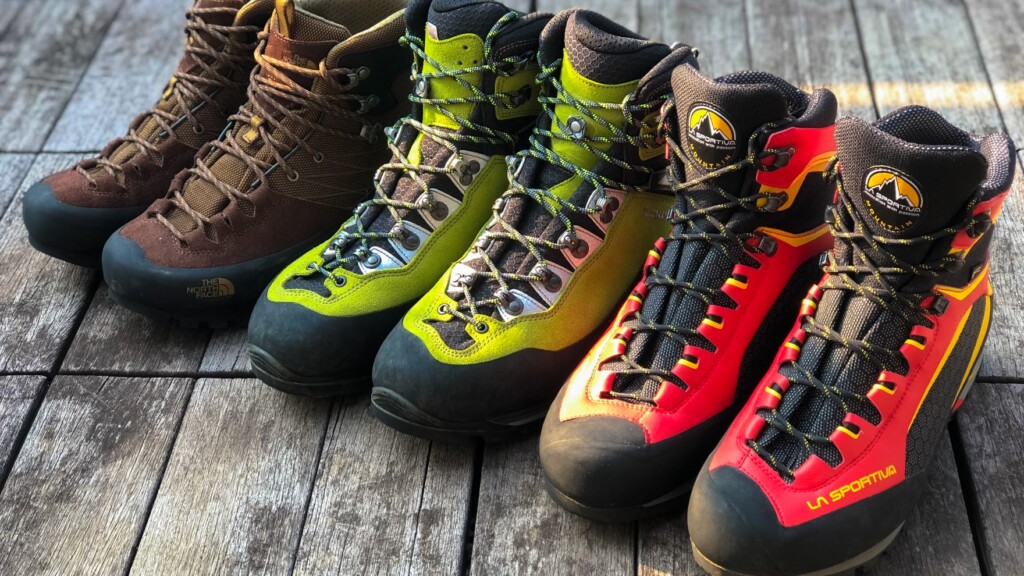
Comparative reviews: Summer, traverse, Alps. We compared light alpine boots that are strong against rocky areas 2018
The summer mountain season has begun, and I'm sure many people are considering which mountain to climb this year.
Everyone has different plans, such as expeditions from low mountains near cities to Japan and abroad. During the snowy mountain season, the snow melts in the Northern Alps and Southern Alps, which are a little less accessible, and many people are planning to make their Alps debut this summer.
When it comes to the Alps, you need to prepare not only carefully, but also your clothing and equipment. Even though it's summer, snowy fields remain on the high-altitude mountains, so crampons are needed to walk safely, and there are many mountains that exceed the limits of forest, so there are many occasions where you will climb rocky areas.
You won't be able to climb with trekking shoes with soft soles, but considering the risk of injuries and other issues, you will need solid climbing shoes that are suitable for your needs. So this time we will review mountain hiking boots that are recommended for mountains with many rocky ridges, including the Northern and Southern Alps.
table of contents
table of contents
- About the items we compared and tested this time
- Test results and spec comparison table
- Impressions of each model
- Detailed reviews of each item (Page: 2)
- Summary (Page:2)
About the hiking boots compared this time
For safe walking along the rocky ridge, climbing boots with stiff soles and strong protection are suitable. Of course, you won't be able to climb even with trekking shoes with soft soles. In fact, when I first started climbing, I used sneakers and shoes that I couldn't call hiking boots. However, while it was light and easy to walk in, every time I climbed, I felt fatigue from my knees (especially my soles of my feet), and sprains and trauma continued. The shoes themselves wear out so much that they sometimes end up crushing one pair of shoes.
When you think about it that way, I think that the best mountaineering shoes are the hard soles and are waterproof and durable. If you suffer from foot pain or fatigue, you will not be able to enjoy climbing the mountain, and you will end up training or penance.
When it comes to mountaineering boots with a hard sole and robust and durable, I think they will become more closely involved in categories such as backpacking models, light alpine models, and mountaineering. However, although the appearance and shape are similar, each manufacturer has distinctive materials, technology, and functions, and range from models specialized for rock ridges to models with a certain degree of versatility. In particular, in Japan, most mountains are walking through forest belts from the trailhead and reaching rocky areas, so a model with excellent rigidity and robustness that is uniformly specialized for rock ridges is not the best. Walking and comfort are also important factors. So, to start this review, we have compiled the selection criteria as follows:
- It must be a model aimed at backpacking and light alpine
- There must be a climbing zone on the sole
- Has a edge on the heel and can be worn with semi-one-touch crampons
With the clear selection criteria, we will move on to selecting specific manufacturers and models, but since most of the major mountaineering boot manufacturers, such as Scarpa, Sportiva, Zambaran, and Garmont, are in Europe and Italy, it is a bit less interesting to compare them alone with Italian manufacturers. So they settled on one new pair of shoes in each country, and settled on three pairs: Sportiva (Italy), Rover (Germany), and the North Face (USA). Normally, we would have wanted to add manufacturers such as Mammut (Switzerland) and Silio (Japan), but we are concerned that the number of products will become thinner as the reviews increase, so we have limited it to three pairs this time.
Test environment
The test period is approximately two months from May to the end of June 2018. The test was conducted mainly in the mountains of Okuchichibu, the Central Alps and the Southern Alps. The walking distance for each test was about 8-15km, and we changed different models on the climb and descent, and compared them on the left and right sides. The tests on the rocky ridge were conducted at Mt. Okuchichibu (Mt. Inokuyama and Mt. Kinmine) as all three pairs were conducted under the same conditions. In addition, detailed test conditions are added in a detailed review of each item.
Five indicators are set as follows for evaluation items. The evaluation figures for the test results are based on my own judgment after the test and are not objective in any way.
- Hardness and grip of the sole: essential for hard mountain hiking, such as heavy luggage or walking on rocky ridges.
- Support: Prevents ankle twisting and displacement inside the shoe
- Comfort, weight... Comfortable to wear and whether you can continue walking for a long time
- Durability: Protects your feet from external pressure such as friction and tearing
- Compatibility with crampons: Easily fit and difficult to remove when passing through snowy fields.
Test results and spec comparison table
Impressions of each model
LA SPORTIVA TRANGO TOWER GTX®
Overall strength is high. Amazing performances, especially on rocky areas.
This is ◎
- Traction and braking performance that are effective in rocky areas
- Robustness that allows you to walk around rocky areas
- Balance of ankle support and mobility
- One-touch crampons fit easily
This is △
- I'm glad that the cushioning was more comfortable with the sole and insole.
- price
The Trango Tower GTX  is the latest model in the slew of Trango series, including Cube, Alpu Evo, S Evo, and Guide Evo . As it is an evolved version of the Trango S Evo, the design is slim shape that follows the S Evo and has a racing car-like shape. The honeycomb-like fabric on the upper is originally a material that increases abrasion resistance, but it also greatly contributes to its cool appearance. In recent years, there have been a large lineup of hybrid mountaineering boots with leather and nylon placed in place, but personally I think it's by far the coolest.
is the latest model in the slew of Trango series, including Cube, Alpu Evo, S Evo, and Guide Evo . As it is an evolved version of the Trango S Evo, the design is slim shape that follows the S Evo and has a racing car-like shape. The honeycomb-like fabric on the upper is originally a material that increases abrasion resistance, but it also greatly contributes to its cool appearance. In recent years, there have been a large lineup of hybrid mountaineering boots with leather and nylon placed in place, but personally I think it's by far the coolest.
Of course, it not only has its appearance, but also has strong and functionality, and the toe, which is the most vulnerable, is covered in double rubber, making it seem as if toe should be climbing a rocky area (?). the Chevedare Pro GT we compared this time , the sole feels a little thinner, and perhaps because of this, the feeling of the soles of the feet can be conveyed more directly. However, even though the sole is thin, the sole with a shank (core material) is hard to prevent twisting and does not bending with a slight amount of force. We actually tested it on a rocky mountain, and when we were able to grasp the bumps and bumps of the rocks, you could feel the traction that sucks into the rocks when climbing.
 Furthermore, I gripped the rocks as I held my grip on the descent, and even though I walked somewhat roughly, I didn't slip. The sole used in this shoe seems to be the same model as the Trango Cube, and it seems to be a product that combines traction, braking and shock absorption, but I think there is no complaints about traction and braking performance.
Furthermore, I gripped the rocks as I held my grip on the descent, and even though I walked somewhat roughly, I didn't slip. The sole used in this shoe seems to be the same model as the Trango Cube, and it seems to be a product that combines traction, braking and shock absorption, but I think there is no complaints about traction and braking performance.
On the other hand, I don't notice any outstanding shock absorption performance, and as I walk for a long time, I start to feel fatigued and exhausted all over the soles of my feet. However, this may be because I got carried away for the test, actively chose unstable scaffolding, and continued walking on the risqué scaffolding for a long time (lol).
Overall, I tried looking somewhere to see if there were any weak points, but I couldn't find them. If I had to point out the question, would it be an insole? I think the original cushioning of shoes should be judged overall, not just the insole alone, but the midsole and outsole, but the construction feels a bit cheap. I felt that if something a little thicker would have a higher impact absorption. Well, if I had to say so... so some people may not mind at all.
LOWA CEVEDALE PRO GT
Not only is it robust, but it also has high comfort and walking performance!
This is ◎
- Tighten the shoelaces tightly and do not interfere with ankle movement
- The exquisite toe space allows you to move freely without pressure on your toes
- A good balance between walking, comfort and robustness, and excellent response
This is △
- It's just heavy
- price
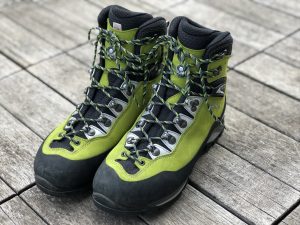 Personally, I was second in the overall rankings at Chevedale Pro GT . With a strong commitment to being 100% made in Europe, the company's TAHOE has gained strong support from core fans. The Chevedare Pro GT we reviewed this time is positioned as a Light Alpine model within the company.
Personally, I was second in the overall rankings at Chevedale Pro GT . With a strong commitment to being 100% made in Europe, the company's TAHOE has gained strong support from core fans. The Chevedare Pro GT we reviewed this time is positioned as a Light Alpine model within the company.
The first thing I felt was that the space in the toes was wide. The feet are fixed from the left and right, but they have an exquisite fit that is neither too tight nor too loose. Wearing mountaineering socks adds cushioning, and I don't think there are many people who get injured by wearing these shoes. The thick ankle cuffs and tongues seem to contribute to walking and comfort, which does not interfere with ankle movement even when the laces are tightened tightly.
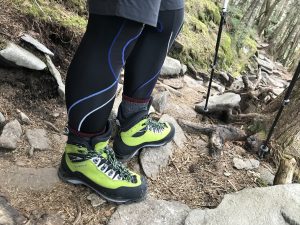 When climbing, it is easier to walk by increasing the range of motion of the ankles, so many people wear them without laces on the top metal fittings, but with these shoes, you won't feel any stress at all when you wear laces on the top metal fittings. In fact, I even felt terrified that if I didn't put it all the way to the top, my ankles would be too free and I would sprain them when I was downhill. The light alpine boots I've worn up so far have a stiff sole, so I sometimes find it difficult to walk on flat or gentle slopes, but with these shoes, the part that touches the shin from the instep, is flexible, so I don't feel that it's difficult to walk in any situation. At the same time, it provides stability on rocky areas and allows you to move your toes, so you can hold your feet on when standing on rocky areas with just the toe, giving you a sense of security even on unstable scaffolding. Through testing, I realized that walking, comfort and robustness are a balanced combination of these three things, and that they are reliable shoes that can be used in any situation.
When climbing, it is easier to walk by increasing the range of motion of the ankles, so many people wear them without laces on the top metal fittings, but with these shoes, you won't feel any stress at all when you wear laces on the top metal fittings. In fact, I even felt terrified that if I didn't put it all the way to the top, my ankles would be too free and I would sprain them when I was downhill. The light alpine boots I've worn up so far have a stiff sole, so I sometimes find it difficult to walk on flat or gentle slopes, but with these shoes, the part that touches the shin from the instep, is flexible, so I don't feel that it's difficult to walk in any situation. At the same time, it provides stability on rocky areas and allows you to move your toes, so you can hold your feet on when standing on rocky areas with just the toe, giving you a sense of security even on unstable scaffolding. Through testing, I realized that walking, comfort and robustness are a balanced combination of these three things, and that they are reliable shoes that can be used in any situation.
The only thing I found to be a problem was the weight. Since they are leather shoes, they are naturally heavy, but the weight of each shoe is about 841g (8.5 UK size) is comparable to mountaineering boots in the harsh winter, which is a bit off the mark from a modern day feeling (lol). And, I would also like to add one more thing: there aren't many mountaineering equipment stores that display and sell them. That's a shame because they are good shoes.
THE NORTHFACE Verbera Lightpacker III GORE-TEX
Among the Light Alpine, this is a versatile model that is particularly easy to walk in, from day trips to the Alps.
This is ◎
- Lightweight and easy to walk in
- Cost Performance
- If you're used to it, it's versatile enough to accommodate day trips to the Alps
This is △
- The shoelaces are difficult to tighten and fit on your feet
- The traction on rocky areas is not that high
- One-touch emblem fit is not very reliable
Velvera Light Packer III 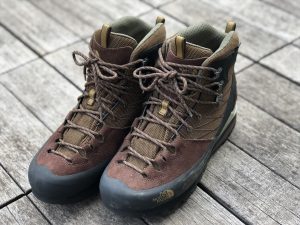 would make you think of them as light trekking shoes . The heel has a edge and supports semi-one-touch crampons, so these hiking boots are designed to be ideal for a range of areas from remaining snow seasons to traversing mountains in the summer. Even when I checked at the store, it seems to be a model with a subtle position that could be described as either a Light Alpine or a trekking boot. Compared to other manufacturers' Light Alpine models (compatible with semi-one-touch crampons), it's a very reasonable price, so if this is enough functional, it's a bargain. Even so, I feel like I'm tempted to make some strange mistakes about whether it's too cheap, but after walking around the area around my house before the test hike, my impression was very light and smooth. The deep toe spring (the toe area has a warp) makes it easy to walk in like sneakers.
would make you think of them as light trekking shoes . The heel has a edge and supports semi-one-touch crampons, so these hiking boots are designed to be ideal for a range of areas from remaining snow seasons to traversing mountains in the summer. Even when I checked at the store, it seems to be a model with a subtle position that could be described as either a Light Alpine or a trekking boot. Compared to other manufacturers' Light Alpine models (compatible with semi-one-touch crampons), it's a very reasonable price, so if this is enough functional, it's a bargain. Even so, I feel like I'm tempted to make some strange mistakes about whether it's too cheap, but after walking around the area around my house before the test hike, my impression was very light and smooth. The deep toe spring (the toe area has a warp) makes it easy to walk in like sneakers.
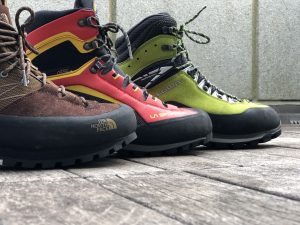 Compared to the other two pairs I reviewed this time, the sole is softer, and this model is more good at traversing than rock ridges. You may hear people say that North shoes have narrow feet, but these shoes use a unique last (wooden mold) that is tailored to Japanese people, and the inside of the shoes is wide and the feel of the feet passing through is good. However, even if you want to improve the fit of the entire shoe, especially the toes, when descending the mountain, it takes quite a bit of force to tighten it, perhaps due to the shape and material of the shoelace holes. The cuffs and tongues are also made of soft materials, but the shoelaces are difficult to tighten and the shallow cut makes the ankle hold weak and unsatisfactory. Even in the actual mountains we headed to during the test, I could feel its lightness and walking ability when I first started walking. Even on rough mountain trails, the highly cushioned sole absorbs impact and I felt it was less tiring even on long distances. The sole has a climbing zone, but to be honest, the fit of the toes and hold the ankle is weak, and the sole is soft, so I think it's not particularly suitable for rocky areas. We will examine the installation of crampons in a detailed review later. Personally, when I hear that it is compatible with semi-one-touch crampons, I often imagine it being used in high mountains, but for these shoes, it would be best to use a lace-locked type instead of a one-touch crampons as an extension of trekking shoes. It is an excellent shoe for traversing summer mountains, pursuing lightness and ease of walking, so it is recommended for those who want to cover everything from day trips to traversing with a pair of climbing shoes.
Compared to the other two pairs I reviewed this time, the sole is softer, and this model is more good at traversing than rock ridges. You may hear people say that North shoes have narrow feet, but these shoes use a unique last (wooden mold) that is tailored to Japanese people, and the inside of the shoes is wide and the feel of the feet passing through is good. However, even if you want to improve the fit of the entire shoe, especially the toes, when descending the mountain, it takes quite a bit of force to tighten it, perhaps due to the shape and material of the shoelace holes. The cuffs and tongues are also made of soft materials, but the shoelaces are difficult to tighten and the shallow cut makes the ankle hold weak and unsatisfactory. Even in the actual mountains we headed to during the test, I could feel its lightness and walking ability when I first started walking. Even on rough mountain trails, the highly cushioned sole absorbs impact and I felt it was less tiring even on long distances. The sole has a climbing zone, but to be honest, the fit of the toes and hold the ankle is weak, and the sole is soft, so I think it's not particularly suitable for rocky areas. We will examine the installation of crampons in a detailed review later. Personally, when I hear that it is compatible with semi-one-touch crampons, I often imagine it being used in high mountains, but for these shoes, it would be best to use a lace-locked type instead of a one-touch crampons as an extension of trekking shoes. It is an excellent shoe for traversing summer mountains, pursuing lightness and ease of walking, so it is recommended for those who want to cover everything from day trips to traversing with a pair of climbing shoes.




